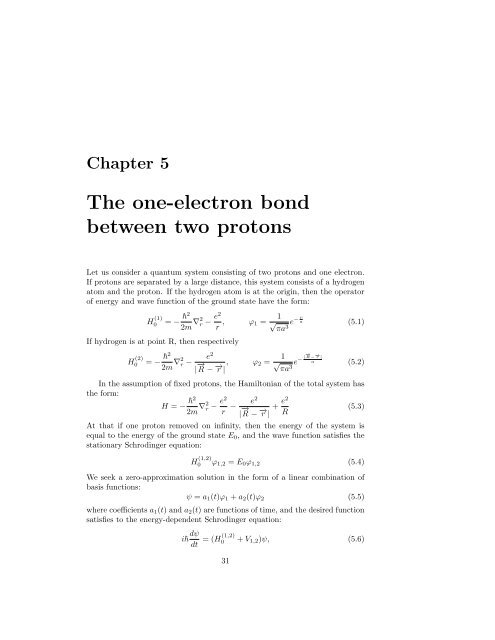VbvNeuE-001
Boris V. Vasiliev About Quantum-Mechanical Nature of Nuclear Forces and Electromagnetic Nature of Neutrinos
Boris V. Vasiliev
About Quantum-Mechanical Nature of Nuclear Forces
and Electromagnetic Nature of Neutrinos
You also want an ePaper? Increase the reach of your titles
YUMPU automatically turns print PDFs into web optimized ePapers that Google loves.
Chapter 5<br />
The one-electron bond<br />
between two protons<br />
Let us consider a quantum system consisting of two protons and one electron.<br />
If protons are separated by a large distance, this system consists of a hydrogen<br />
atom and the proton. If the hydrogen atom is at the origin, then the operator<br />
of energy and wave function of the ground state have the form:<br />
H (1)<br />
0 = − 2<br />
2m ∇2 r − e2<br />
r , ϕ 1 = 1 √<br />
πa<br />
3 e− r a (5.1)<br />
If hydrogen is at point R, then respectively<br />
H (2)<br />
0 = − 2 e 2<br />
2m ∇2 r −<br />
| −→ R − −→ r | , ϕ 2 = √ 1 |−→ R − −→ r |<br />
πa<br />
3 e− a (5.2)<br />
In the assumption of fixed protons, the Hamiltonian of the total system has<br />
the form:<br />
H = − 2<br />
2m ∇2 r − e2<br />
r − e 2<br />
| −→ R − −→ r | + e2<br />
(5.3)<br />
R<br />
At that if one proton removed on infinity, then the energy of the system is<br />
equal to the energy of the ground state E 0 , and the wave function satisfies the<br />
stationary Schrodinger equation:<br />
H (1,2)<br />
0 ϕ 1,2 = E 0 ϕ 1,2 (5.4)<br />
We seek a zero-approximation solution in the form of a linear combination of<br />
basis functions:<br />
ψ = a 1 (t)ϕ 1 + a 2 (t)ϕ 2 (5.5)<br />
where coefficients a 1 (t) and a 2 (t) are functions of time, and the desired function<br />
satisfies to the energy-dependent Schrodinger equation:<br />
i dψ<br />
dt = (H(1,2) 0 + V 1,2 )ψ, (5.6)<br />
31












